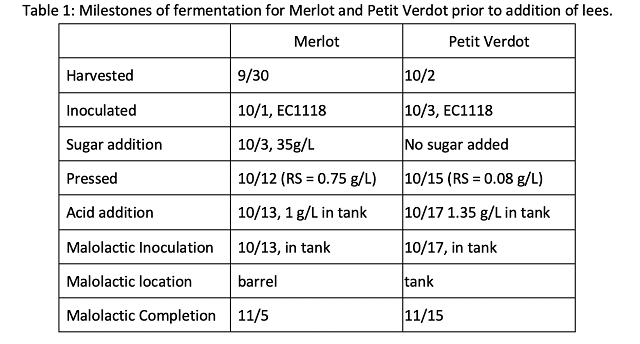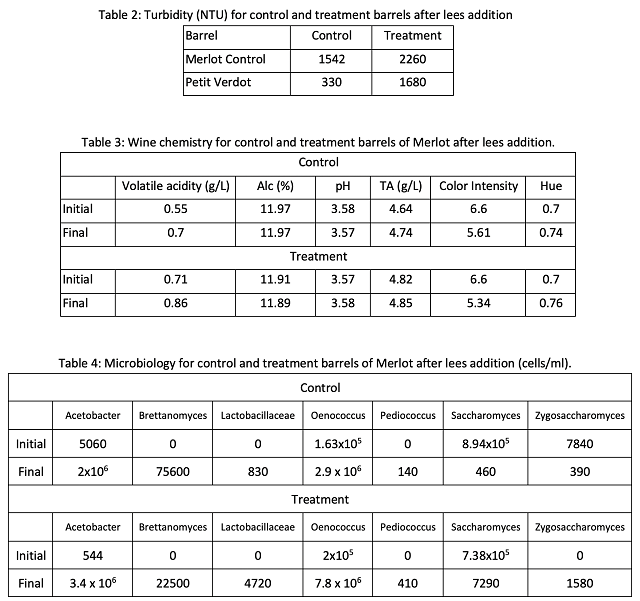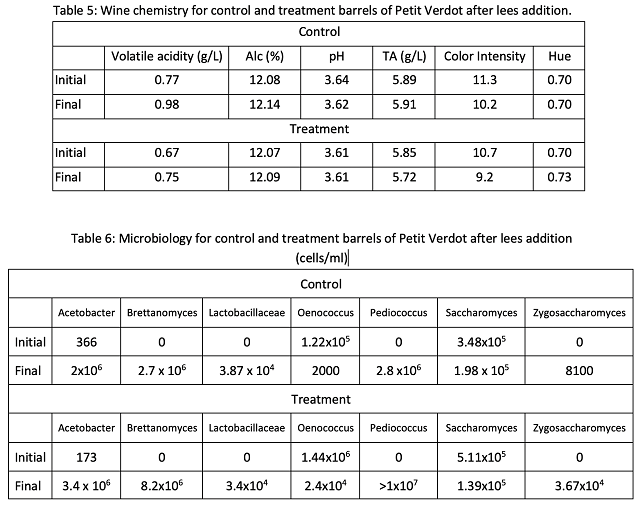The impact of lees stirring in Merlot and Petit Verdot (2018)
Kirsty Harmon
Blenheim Vineyards
Summary
The 2018 vintage in Virginia included high rainfall, causing many winemakers to pick grapes with less maturity and higher dilution than desired. This often led to wines that were thin and herbaceous in character. One of the most common tools in the winery for the addition of body/volume during élevage is the use of yeast lees1. This study examines the impact of lees addition and barrel stirring on the mouthfeel and astringency of Merlot and Petit Verdot wines. There was very little difference in general chemistry between control and lees stirred wines. Lees stirring did not appear to increase volatile acidity. Loss of color was more pronounced in lees stirred Petit Verdot than control; this difference was not seen in the Merlot barrels. The barrel receiving lees addition in Petit Verdot had higher levels of Pediococcus and Zygosaccharomyces than control after aging. Lees treated Merlot was able to be distinguished from control in a blind triangle test, with a nearly significant difference in fruit intensity (treated wine had higher fruit intensity).
Introduction
The 2018 vintage in Virginia included high rainfall, causing many winemakers to pick grapes with less maturity and higher dilution than desired. This often led to wines that were thin and herbaceous in character. One of the most common tools in the winery for the addition of body/volume during élevage is the use of yeast lees1. During aging, yeast lees can add to the perception of body, reduce the perception of astringency, and help protect wine from oxidation. Yeast lees can originate from the fermentation, be added from other fermentations, or be purchased from an enological company. If using yeast lees from fermentation, take care that the lees are clean and do not contain spoilage organisms. Sur lies aging is a useful tool for adjusting wine balance post-fermentation in pursuit of greater wine harmony.
Wine body comes in part from polysaccharides1. Chemically, polysaccharides are chains of sugars bound together, with an average of 20 subunits per chain2. Grapes contain polysaccharides but these form complex colloids during fermentation, most of which precipitate out in the presence of alcohol. This means the grape polysaccharide level in finished wine is generally low1. Polysaccharides become more extractable as grapes ripen, so in years where grapes are underripe (such as 2018 in Virginia), the initial extraction of grape polysaccharides can be low, further diminishing the body of the wine1.
Yeast contribute the majority of the polysaccharides in wine. Yeast cell walls are made up of mannoproteins, a complex of peptides and the polysaccharides mannan and B-glucan. During fermentation and after cell death, the enzyme B-1,3-glucanase releases these polysaccharides from their protein partner, increasing the polysaccharides in the wine 1,3,4. The overall amount and type of polysaccharides produced by the yeast depends on the yeast strain as well as the conditions of growth. For example, fewer mannoproteins are produced in high turbidity fermentations than fermentations with lower turbidity4. Aging on yeast lees is meant to provide the time needed for cell breakdown and release of polysaccharides to the wine.
In addition to adding body on their own, polysaccharides contribute to the perception of body by complexing with tannins4,2. Tannins are perceived as astringent because they complex with salivary proteins that provide lubrication. When these proteins are bound to tannins, lubrication is missing, leading to an astringent sensation. Polysaccharides interact directly with tannins, which prevents them from binding to salivary proteins. With salivary proteins intact, tannins are not perceived as harsh2. The interaction of polysaccharides with tannins does not interfere with normal tannin polymerization, which means addition of polysaccharides to the wine through lees addition will not prevent the maturation of the wine2.
Aging wine on yeast lees can have several additional chemical and sensory impacts on the wine:
- Mannoproteins in wine help contribute to tartrate stability by capping growing tartrate crystals2.
- Cell walls of yeast are a reductive surface, helping to scavenge oxygen introduced during barrel aging and stirring, but can themselves contribute to reductive odors if not managed carefully1,4.
- Interaction of polysaccharides with oak tannins reduced the adsorption of fruity esters by oak cooperage1.
- Breakdown of yeast lees during aging releases micronutrients and sugar, which can encourage growth of malolactic bacteria but also spoilage organisms such as Brettanomyces1,4 Other yeast metabolites released during cell breakdown include ethyl octanoate and ethyl decanoate that add fruity character to the wine and contribute to enzymatic reduction that diminishes sensory impact of carbonyl compounds like diacetyl1.
- Lees can lead to a decrease in the color of the wine by binding to anthocyanins directly as well as absorbing oxygen that is needed for the formation of anthocyanin-tannin complexes (which can also lead to dry tannins)4.
Practically, sur lies maturation (the aging of wine on yeast cells), is employed fairly extensively worldwide. The general practice includes 3-6 months of contact with lees with periodic stirring During this time, dead and dying cells autolyze in a staged breakdown of the yeast1. Sur Lies élevage can be done on lees from the primary fermentation or using added lees from other fermentations. Some have used lees from finished white wine fermentations, others have added dry yeast5. If taken from primary fermentation, Zoecklein (2005)6 makes the distinction between heavy lees and light lees. Heavy lees are those that settle out in the first 24 hours and can contain unwanted materials such as pulp and tartrates while light lees are those still present in solution after 24 hours. The light lees contain living and dead cells and are the desirable portion for sur lie maturation.
Weekly to monthly battonage is usually recommended when aging sur lies for several reasons. Stirring helps break down the cell walls, releasing B-1,3-glucanase enzymes and mannoproteins4, and favors diffusion of nutrients, mannoproteins, and flavorants from yeasts into the wine1. As mentioned above, lees are reductive surfaces which can lead to the production of sulfur-like off odors in the wine. The threat of reduction is exacerbated by pressure in larger vessels such as tanks or foudres1,4. Stirring homogenizes the redox potential of the wine from the top of the vessel to the bottom, leading to less reduction at the bottom. In addition, opening the bung of a barrel or the top of the tank to stir introduces oxygen, which can limit reduction. Care must be taken, however, as the introduction of oxygen can also lead to formation of acetaldehyde and potentially lead to acetic acid production4. Stirring also distributes any spoilage organisms that may be present in the bottom of the barrel.
Several commercial products are available to provide sources of yeast mannoproteins if endogenous sources are not available. These include activated dry yeast, inactivated yeast hulls rich in mannoproteins, mannoproteins already isolated from yeast, and purified polysaccharides from yeast as well as other sources. Gum Arabic is a polysaccharide from gum trees that is often used for this purpose2. Isolated B-1,3-glucanase is also commercially available to speed up autolysis. Each product has different efficacy, price point, and time required for activity, so care should be taken in choosing the product that will provide the desired effect(s) in the time available. Several WRE trials have been done using lees aging in white and red wines. Results for these trials can be found on the Winemakers Research Exchange website (http://www.winemakersresearchexchange.com). Laffort did a series of trials with its version of the B-1,3-glucanase enzyme in 20167.
The overall effect of yeast lees aging on the balance and harmony of the wine is to increase fruit intensity and body while diminishing herbaceous/green character and astringency4,2. Sur lies aging takes time, and includes risks of spoilage. However, this approach can provide a powerful tool for élevage of a truly harmonious wine. This study examines the impact of lees addition and barrel stirring on the mouthfeel and astringency of Merlot and Petit Verdot wines.
Procedure
Merlot
Both treatments originated from the same fermentation lot. Merlot was made with the winery’s standard protocol with the sole exception of lees stirring. Briefly, grapes were picked, chilled overnight, sorted, destemmed and loaded into T-bins with 50 mg/L SO2. Tanks were inoculated at a rate of 15g/hL of EC1118 yeast after the bin temperature reached 10°C/50°F (the day after processing). Fermentation was monitored for Brix and temperature each day. Cap management by punch down was completed twice daily throughout the fermentation until Brix were -1.5 or lower. After sugar was depleted, bins were drained and pressed with fractions combined. After pressing, wine was settled in tank for at least 24 hours, racked to a separate tank for additions, then inoculated for malolactic fermentation with Scott Labs MBR process at a rate of 1 g/225L barrel. This resulted in wine being racked twice, once after 24 hours of settling to remove gross lees, and again 24 hours later at barrel down, so that the lees added to barrels for the stirring regime were fine lees.
At the time of barrel down, clean wine (with as little lees fraction as possible) was racked to newly cleaned barrels of the same age and cooperage. Control barrels received no additional lees. Treatment barrels received 4 liters of fine lees from the bottom of the settling tank. Turbidity before and after lees addition was measured.
Malolactic fermentation was monitored in barrel until enzymatic analysis measured less than 0.03g/L. After completion of malolactic fermentation, 50 ppm SO2 was added. Table 1 summarizes the timeline of progress as well as additions made to this wine.
Barrel stirring began on November 15, after completion of malolactic fermentation and addition of SO2. Control barrels were not stirred. Trial barrels were stirred for a total of 2 minutes once per week for 3 months. SO2 was monitored once every 4 weeks and a level of 0.5 molecular SO2 (30ppm free SO2) was maintained for both barrels.
Sensory analysis was completed by a panel of 21 wine producers. Wines were presented blind in randomly numbered glasses. Tasters were presented with three wines, two of one type and one of another, and asked to identify which wine was different (a triangle test). There were three tasting groups with the unique wine in the triangle test balanced between groups. Tasters were then asked to score each wine on a scale of 0 to 10 for fruit intensity, body, herbaceous/green character, and astringency. They were also given open ended questions to describe the wines. Results for the triangle test were analyzed using a one-tailed Z test. Descriptive scores were analyzed using repeated measures ANOVA.
Petit Verdot
The same procedure was followed with Petit Verdot grapes with the following exceptions: After pressing, wine was racked after 24 hours, then allowed to settle for 9 days for the settling of fine lees prior to its second racking. Addition of tartaric acid was made, and wine was inoculated with Scott Labs MBR Process. This wine completed malolactic fermentation in tank prior to barrel down. After the completion of malolactic fermentation (less than 0.03 g/L by enzymatic analysis), 50 ppm SO2 was added and wine was transferred to newly cleaned barrels of the same age and cooperage.
The control barrel received no additional lees. The treatment barrel received 8 liters of fine lees from the bottom of the settling tank. Turbidity before and after lees addition were measured. Table 1 summarizes the timeline of progress as well as additions made to this wine. There was no sensory analysis of Petit Verdot.

Results
Merlot
Merlot had a relatively short settling time (24 hours) due to production constraints, leading to a relatively high turbidity in the control lot, however, addition of lees still increased the turbidity of this wine (Table 2).
Initial wine chemistry for each barrel was determined on November 26, 3 weeks after transfer to barrel and lees addition (Table 3). The general chemistry of the lots was largely the same with the exception of a difference in acetic acid content. This wine underwent malolactic fermentation in barrel, so differences in initial acetic acid content in this lot may be due to differences in malolactic fermentation kinetics. Both lots had an increase of 0.15 g/L acetic acid during aging.
Both barrels also showed a decrease in color intensity over time, with slightly more color lost in the treatment barrel than the control barrel (Table 3). Color hue increased during aging, likely due to the formation of polymeric anthocyanins or oxidation of pigments. Differences in color intensity and hue were similar for both barrels.
Aging also had an overall impact on wine microbiology (Table 4). Initial microbial loads were likely due to lees still present in wine at the time of barrel down. Increase in Oenococcus is consistent with malolactic fermentation. High levels of acetic acid bacteria, Brettanomyces and Oenococcus occur in both barrels, indicating this is not due to stirring alone, but more likely due to the conditions of the vintage.
In a triangle test of control and lees stirred wines, 17 out of 21 respondents were able to distinguish which wine was different, indicating the wine were significantly different (Z=4.4, p<1x10-5). The mean score for fruit intensity in the control was 5.18 (SD=1.07) while the mean in the lees stirred wine was 5.96 (SD=1.43), a difference that was nearly significant (F=3.87, p=0.06). There were no significant differences in scores for body, herbaceous/green character, or astringency, though several respondents listed herbaceous or tannin qualities as those which helped distinguish the wines. Others listed reduction in the control wine, a state that may be due to relatively high lees load without stirring.
Petit Verdot
Addition of lees increased the turbidity of the wine 5 fold (Table 2). Wine chemistry was determined for each barrel on November 26, 1.5 weeks after wine was put in barrel. For both wines, residual sugar was <1 g/L and malic acid was <0.15 g/L. There was an initial difference in acetic acid between the two lots (Table 3) with the control wine having higher acetic acid than the lees treated wine. This wine completed malolactic fermentation in tank and was transferred to barrel only 1.5 weeks prior to the sample being taken. Therefore, the difference in acetic acid is most likely due to barrel variation. The control barrel had a higher volatile acidity to begin, and also a larger change in volatile acidity during aging (0.21 g/L compared to 0.08 g/L in the lees stirring barrel).
As with Merlot, both barrels lost color intensity with aging, however, in Petit Verdot, color loss was higher in the barrel with lees stirring. The control barrel had a color loss of 0.9 units while the lees stirred barrel had a color loss of 1.5 units. Lees can bind to phenols, including anthocyanins, so high levels of lees contact can reduce color8.
There was a relatively high microbial load in both control and treatment wines, with the treatment wine showing higher levels of Oenococcus, Pediococcus, and Zygosaccharomyces than the control (Table 4). Oenococcus is associated with malolactic fermentation. Pediococcus, another wine bacteria, is commonly found in wineries. Higher numbers occur in mature, wounded or infected fruit9. It generally metabolizes sugars of several kinds, and can produce acetoin and diacetyl9 as well as high levels of volatile acidity1. This bacteria is also the cause of ropiness in wine. Ropiness occurs when bacterial cells produce a polysaccharide coating that causes the cells to stick together in threads. These threads can be broken apart when agitated (such as during lees stirring), a dispersal that can lead to an oiliness or viscosity to the wine1.
Zygosaccharomyces is a SO2 and sorbate tolerant yeast that is commonly associated with bottle spoilage of sweet wines. However, even in dry wines it can produce spoilage levels of acetic acid and higher alcohols as well as acetoin and diacetyl. High levels of Zygosaccharomyces are associated with sour rot in grapes1.


Preliminary Conclusions
- One day of lees settling in Merlot produced much higher level of lees in the control than 9 days of settling in Petit Verdot. Those allowing only one day for red wine settling should be aware of higher levels of lees carryover into aging wines.
- There was very little difference in general chemistry between control and lees stirred wines. Lees stirring did not appear to increase volatile acidity.
- Color was lost in all of the barrels with aging. Loss of color was more pronounced in lees stirred Petit Verdot than control; this difference was not seen in the Merlot barrels. Color loss in Petit Verdot may have been greater due to a greater difference in overall lees load, or due to higher color in Petit Verdot to begin with.
- The barrel receiving lees addition in Petit Verdot had higher levels of Pediococcus and Zygosaccharomyces than control after aging. These are both associated with infected fruit. Stirring may have encouraged additional growth of these potential spoilage organisms.
- Lees treated Merlot was able to be distinguished from control in a blind triangle test, with a nearly significant difference in fruit intensity (treated wine had higher fruit intensity). Other stated differences were in perception of tannin and herbaceous/green character, though scored for these descriptors were not significantly different.
References
(1) Jackson, R. S. Wine Science: Principles and Applications, 4 edition.; Academic Press: Amsterdam, 2014.
(2) Chauffour, E. Understanding Wine Mouthfeel: The Art of Winemaking.
(3) Dharmadhikari, M. Yeast Autolysis* https://www.extension.iastate.edu/wine/yeast-autolysis (accessed Dec 24, 2019).
(4) Zoecklein, B. W. The Nature of Wine Lees. Enology Notes 2012 No. 162.
(5) Zoecklein, B. Yeast Fining. Enology Notes 2004, No. 85.
(6) Zoecklein, B. Lees Management. Enology Notes 2005, 106.
(7) Report | ARC by Laffort.
(8) Zoecklein, B. W. Sur Lie Storage of Red Wines. Enology Notes 2002, 41.
(9) Wine Microbiology. UC Davis Viticulture and Enology.
